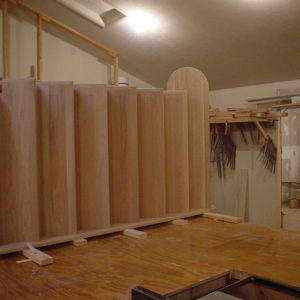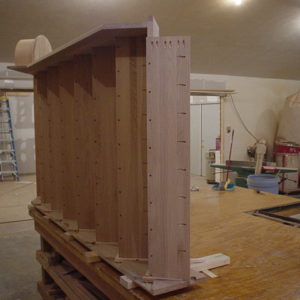This is the bottom section of a 19 tread straight stairway. I have already built and installed the top 12 tread section..and this bottom section will be mated to the other one next Monday.
This is all white oak..mortised 5/4 stringers, 4.5 inch base newel posts yet to be installed.


























Replies
Aren't they supposed to go up?<G>
Do you build them on their sides, or is it just ready to go out?
Pretty work, no matter which way they go...
EliphIno!
buck: I build my straight stairs on my workbench on their side.
I just make sure the mortised stringer is shimmed straight and level both lengthwise and crosswise. Then as long as the treads and risers are exactly vertical both ways...this assures the stairs are square.
It works real slick. I usually spend one day routing the stringers, cutting all the treads and risers to size. pocket screwing all the parts...then that section of stairs just took about three hours to assemble. I dont do very many straight stairways, but they are good in betweeners sometimes
Edited 3/28/2003 7:00:06 PM ET by Stan Foster
very nice work, looks great, how about some pics when installed?
Stan, acouple of weeks ago I did a stair out of white oak and I was amazed at the different density of wo. It seemed liked it wouldn't absord glue, when I put fittings together the glue just squirted out, so I put less glue on and it still squirted out, much different than red.
Allen: Yea...the pores in white oak are filled with lignum. Red oak is open pored and thats why you can see hundreds of open pores when you cut off a thin wafer of endgrain.
White oak takes stain better since it doesnt have those open pores soaking up the stain making the grain more vivid.
Stan I remember you posting something about the tread returns. You us a pattern and router to get that swoop right? Nice work.
Paul: Thanks.....Here is the picture of the swoop return that guides a flush cutting bit for the tread cut. The second picture is the tread return being cut with a jig that is a mirror image of the tread jig.
The last pictures show the tread return pocket screwed on..and the finished return on the tread
Let's go to the landing tread. I am anxious to see the pattern-cutting for the tread, and particularly, the techniques for bending the riser, and then fastening tread to riser at the rounded end. I suspect you heavily kerfed the back of the riser, way out to within 1/8" of the surface, and then bend it around form blocks.
Mr. Micro: Those pictures just posted about doing a swoop miter were from another stairway I did last year. You are right about kerfing the riser backs. I only kerf what is necessary and if I recall..that stairways riser radius was done with 3/8 inch deep kerfs.
Stan, do you have your pattern router bits re-sharpened?
Allen: I just touch them up with a diamond hone...but as cheap as the bits are..I just replace them after a few touch ups.
Edited 3/30/2003 7:55:18 AM ET by Stan Foster
I would have to agree with Stan, I use Whiteside bits, they last a long time, touch them up several times and toss'em. Tried sending them out to get sharpened but they never seem to come back as good as the original.
I only used white oak once, seemed harder to resaw and more brittle to work with, but then maybe it was just the one batch I used.
Armin: White oak without a doubt is superior to red oak. It has closed pores..smells nice, the grain is less vivid as red oak is since red oak has open pores and soaks up the stain much more causing the grain to be more pronounced.
Whiskey barrels are mostly made out of white oak as it is so stable. Also, of course, quartersawn white oak with its flame grain is very common for furniture makers.
However, usually the owner doesnt want to pay the difference. White oak is higher,,and the railing and fittings are less common and much more expensive.
The bottom stair section that I have shown in this thread is going to mated Tuesday to the already installed upper 12 tread section. The owner has already applied the finish to the top section and the white oak really looks much nicer than the stairs I make in red oak.
Edited 3/30/2003 2:11:33 PM ET by Stan Foster
Stan and Armin,
JLC has a nice picture gallery now, if you have the time I'm sure those guys would love to see some of your work. It can be accessed through Finish carpentry forum
What kind of glue do like for white oak? I just found out I've got to make a chimney surround (one part might be 5'x 8') out of glued up white oak boards. Do you glue up your treads? What works? Thanks. EliphIno!
bucksnort: Titebond glue is excellent. If you glue edge grain..it will always break away from the joint.
So, you're telling me I'm out of luck with this panel, eh? I've used white oak treads that were edge glued, and, there was no separation problem, guess they had good lawyers<G>
Dang, I'm pretty sure I've got to do this, think Gorilla-like glue might do it? EliphIno!
bucksnort...I would use titebond. It is stronger than the joint. Just do your own test. Glue up two boards along their edge, let the glue cure and place the joint over the edge of a bench and try to break the board at the glue joint. It will almost always break away from the joint.
Dang, I've been especially thick the last couple of days. Doh! EliphIno!
Thanks once again for the pics, Stan.
Forgive my curiosity, but I've gotta ask. Do you experience any cracks in the treads due to fluctuating humidity levels in the home or do are the pocket screws able to tip enough in their bores to allow for the required relief of stress? Can't help but notice that cross-grain situation that we all face in various designs.
Since you're quite the seasoned pro, I'm suspecting that you use glue out near the tip of these swooped miters but only the screws are holding the rest of the return.
I don't see any evidence of a t&g along that edge that would help keep things in vertical alignment while allowing movement to prevent splitting. Unnecessary?
Are you gaining some control of this potential by dictating finish to the client?
Knowledge is power, but only if applied in a timely fashion.
Goldhiller: The swoop returns are put on with six pocket screws and titebond glue. I have had real good results with the tread returns put on this way.
I think a lot has to do with my shop which is climate controlled..I heat it of course..but also it is airconditioned. The houses my stairs go into are almost always airconditioned when I set the stairs. One exception is the stairway I just set last week in a house that doesnt even have heat, or drywall in yet. I am going to monitor those tread returns closely to see if they try to do anything.